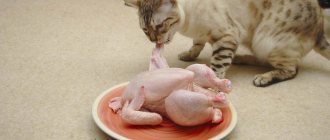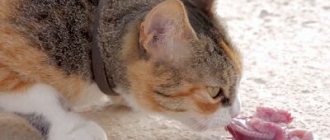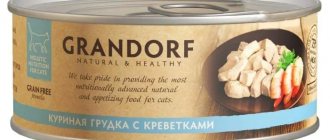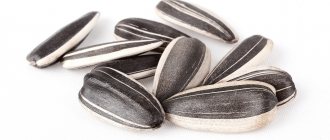Content
1. What are the benefits and harms of pork meat 2. What are the dangers of pork 3. Is it possible to give boiled meat 4. Pork in industrial feed
Cats are small predators, carnivores, whose diet is based on meat. But not all meat can be given to pets, so to the question: “Can a cat be given pork?”, veterinarians give a negative answer. And this is no coincidence: a stolen piece of meat from the table can play a cruel joke on your pet and send it straight to the veterinarian.
Which types to give preference to?
A cat's diet can be combined from several types of meat products:
- Lean beef. Contains a large amount of protein, moderate amount of fat, rich in taurine. It is believed that this meat brings the greatest benefit to the cat’s body. It can be given to your pet every day.
- Mutton. Only lean pieces. Can be given every day.
- Rabbit meat. Contains less protein and fat than beef. Recommended for cats that are overweight or have kidney failure.
- Turkey meat. Rich in protein and lean meat. It is advisable to alternate with beef.
- Chicken. Chicken meat is easily digestible, suitable for dietary nutrition, and contains a lot of protein. A number of experts, however, are wary of it because of modern methods of raising chickens (the use of hormonal supplements, antibiotics by producers, feeding salt before slaughter, etc.). Like turkey meat, you can give it from time to time.
- Fish. Only sea and boiled. No more than 200 g per week is allowed.
- Offal. The hearts can be chicken or turkey. Beef liver, lungs or tripe are preferred. By-products must be present in the diet, but not more than 200 g per week. Liver is given especially carefully: raw liver relaxes the intestines, and boiled liver strengthens it.
- Chicken necks without skin. They contain a lot of calcium, which other types of meat products are poor in. Some advise turning them through a meat grinder or beating them with a hammer, others recommend giving them whole. Focus on the capabilities of the pet itself: a kitten may not chew its neck, but a large cat can handle it easily. 3-4 raw shakes per week are allowed.
- Chicken heads. The most controversial product. The brain they contain is certainly beneficial for pets, but small bones, according to some veterinarians, can clog or injure the intestines. Other experts insist that chicken heads are essentially “mice” for cats, which these predators eat whole, and that the thin bones of the skull are easily digested. One way or another, no more than 2-3 goals per week are allowed. Please consult your veterinarian before adding this product to your pet's diet. Please also keep in mind that this is rough food, and it can really cause harm to a cat who has lived for years on soft, easily digestible food.
Now let's find out what types of meat should not be fed to cats, even in small quantities. These include:
- pork;
- fatty lamb;
- fatty poultry (geese and ducks);
- chicken skin;
- purchased minced meat (their composition may be far from what is stated);
- large and tubular bones - they injure and clog the esophagus;
- any fried, smoked and salted meat;
- canned food and sausages.
Some owners wonder why cats should not be given pork, such as lean parts of the carcass. The fact is that this meat often causes intestinal upset in pets.
What are the benefits and harms of pork meat?
Pork is considered the most easily digestible meat (after lamb), and even fat is less harmful when compared with beef. It turns out that pork contains a lot of B vitamins, which is not found in either beef or lamb. In addition, it contains:
- vitamin E is a powerful antioxidant;
- oleic acid;
- linoleic acid.
Both of the latter unsaturated fatty acids are among the most important for any living organism, including domestic animals. Linoleic acid helps lower cholesterol, reduce the risk of developing diabetes and cardiovascular diseases.
It is believed that pork meat has a positive effect on the central nervous system: sleep is normalized, mood improves, and the risk of depression is reduced.
Eating pork has a positive effect on digestion - it prevents the development of colitis and intestinal atony, and helps reduce acidity in the stomach. However, all these positive qualities of meat appear when it is consumed by humans. Cats can't eat pork!
The main dangers of pork
What dangers could your cat face when consuming this meat product? There are problems, and serious ones. Unfortunately, pigs themselves are susceptible to many dangerous diseases. In order to get sick, your pet only needs to eat raw meat from a sick animal.
Pork is quite a fatty product, this should also be kept in mind. Finally, many cats are diagnosed with individual intolerance to pork and experience allergic reactions.
Trichinosis
As for trichinosis, it is a very dangerous infectious disease. Infection mainly occurs through eating raw meat. In the last century, this was a real scourge for both farmers and veterinary services. Thank God, thanks to the effective system of measures adopted, the risk of purchasing contaminated meat is minimal. If you want to treat your pet to raw pork, purchase products intended for human consumption and only from trusted places. Never experiment with game - wild boar, elk, bear meat, etc.
Doctors say that trichinosis can be treated well with the same medications as roundworms. True, Trichinella larvae, which find refuge in muscle tissue, pose some danger.
Trichinella is spread by mice and rats. Be careful if your cat hunts rodents on the street, much less eats them. Then you will wonder for a long time where your pet contracted trichinosis.
Trichinella can be killed at home. Trichinella are afraid of heat treatment. Regular cooking of meat in a saucepan is not suitable. Suspicious meat must be cooked in the oven for at least an hour. At the same time, combine business with pleasure - you will have a wonderful roast. Don't forget to give your cat a piece.
High fat content
As for the high fat content in pork, there is no cause for alarm. Unless, of course, you give your cats raw pork meat and nothing else. And a piece of lean meat a day will only do you good.
In addition, in a pork carcass, in addition to areas that are truly saturated with fat, there are also so-called lean areas - carb, tenderloin, and shoulder. There is even less fat here than in chicken. Accordingly, with the right approach, pork can also become a dietary product.
Allergy
Cats either have a pork allergy or they don't. In the first case, do not take unnecessary risks, abstain from meat. The second point - do not put any food that is new to your cat in its bowl in excess. Introduce everything new gradually and see what comes of it. The first experiment was successful - you can continue to introduce new food further. Do not put too much stress on the animal's gastrointestinal tract.
Why is pork dangerous?
Pig meat is the fattest among other types of this product, which, if consumed frequently, can cause the cat to develop serious and dangerous diseases: pancreatitis and even chronic renal failure or cirrhosis of the liver. The most “harmless” consequences of eating a piece of pork can be intestinal upset or an allergic reaction.
Allergy
Meat contains components that can cause allergies. It contains a large amount of histamines, which cause various dermatological diseases (eczema, dermatitis) and bile stagnation.
Helminthiasis
But the most dangerous thing is that when eating pork there is a high risk of becoming infected with intestinal parasites. Raw pork is the most common source of tapeworm infestation. Tapeworms can parasitize a cat's intestines and grow up to two meters in length. Often, helminthiasis is asymptomatic, which gives the worm the opportunity to actively grow and reproduce. If the size of the parasite is too large, the cat may develop intestinal obstruction.
Pork is often a source of Trichinella infection. Trichinosis is a dangerous disease not only for cats, but also for humans. It is quite difficult to remove parasites from the body after infection, but it is easy to become infected. There are often cases when even heat treatment of meat does not help protect against them.
After entering the animal’s body, the parasites live in the intestines for up to one and a half to two months, then migrate throughout the body and penetrate the muscles. Here Trichinella can exist for several years. Symptoms of the disease are:
- muscle pain;
- swelling;
- a sharp rise in body temperature;
- intestinal disorder;
- skin rashes;
- hemorrhages in the eyes.
Trichinosis can be cured, but is it worth exposing your beloved pet to the risk of infection?
Pancreatitis
Another reason why pork is not recommended for cats is the high amount of fat in the meat. Even lean meat contains up to 2.8% fat, and pieces with lard contain even more – up to 27%. But pets are spared the need to move a lot to get their food. They sleep 20 hours a day, so excess fat in their diet will lead to it not being absorbed in the body and not being converted into energy. As a result, your furry pet will face obesity and associated diseases of the cardiovascular and other body systems.
Important!
Excess fatty foods in a cat's diet leads to pancreatitis.
Inflammation of the pancreas (pancreatitis) has vague symptoms, which complicates treatment. With pathology, the enzymes produced by the pancreas are activated not in the duodenum, but in the gland itself, and as a result, its self-digestion begins. This leads to the formation of toxins that poison other internal organs.
In addition, the pancreas is responsible for the production of insulin in the body. It is necessary for cells to receive enough glucose. A malfunction of the organ causes an uncontrolled release of sugar into the blood; as a result, pancreatitis can lead to diabetes.
Oncology
Pork blood contains endobionts. This scientific name means cancer cell markers. However, not a single study has proven a direct connection between the development of cancer cells and eating red meat (this type of product includes not only pork, but also beef, lamb, etc.).
The nuances of purchasing pork
This product has earned a bad reputation because owners make mistakes when purchasing it. But they can be avoided quite easily:
- You should take a responsible approach to purchasing any meat products, and pork is no exception. It is recommended to avoid spontaneous markets where sanitary standards, storage and sales conditions are not observed. You shouldn’t think that if the van of a dubious car says “homemade, fresh, fresh meat”, then that’s what it is. Often, a product from “their own farm” turns out to be written off and “refined” as a store product. In addition, it is rare that small farms follow all the rules for raising livestock, carry out regular vaccinations, and store meat in appropriate conditions. When purchasing pork from a private seller, you can play it safe and ask for a certificate issued by the veterinary control.
- Sellers' tricks. And what “miraculous” tricks do some unscrupulous traders have to give a stale product an appetizing appearance! For example, aging in a salt solution and subsequent coloring makes the product not only more attractive, but also significantly larger and heavier. Such meat will definitely attract the attention of buyers. Also, expired food gets a “new life” after marinating and packaging in separate, sealed bags. Marinades perfectly eliminate the putrid “smell” of the product. And hermetically sealed packaging does not allow the “aroma” of rot to be captured. It also compresses the product, making it look denser and more attractive. Meat products in a vacuum are a fertile breeding ground for all kinds of pathogenic microorganisms.
- When buying pork, regardless of whether it is intended to feed people or a domestic cat, you should remember that the product should only be stored in the freezer or on the shelf of a refrigerated counter. In addition, it must be protected from dust and the hands of potential buyers. You should carefully look at the shelf life of the product and the seller’s compliance with personal hygiene measures. If the meat is weathered and flies are crawling on it, then it is better to avoid such goods without endangering yourself and your furry pet.
Is it possible to give boiled meat?
Heat treatment of pork does not reduce the harmful properties of meat. On the contrary, after it the beneficial substances contained in the product are also destroyed. After cooking, up to 2/3 of taurine and thiamine are lost in pork, and the protein is denatured. In a cat's body, boiled pork is digested much worse than raw pork.
However, there are viruses that are destroyed only by cooking meat. So, a pig can get sick with the so-called false rabies (Aujeszky's virus). The disease is not dangerous to humans, but is fatal to animals. A pig can remain a carrier of the virus, and its meat will be safe only after heat treatment (boiling for at least 15 minutes in boiling water).
Dry and canned industrial feed
Lots of salt and preservatives, but little benefit - the statement is quite fair if we are not talking about professional brands. Whisk**, Kitek**, Friski** and similar brands are exactly what should not be fed to sterilized cats, and it is not recommended for street animals. If your pet has a breed tendency to pathologies and you are forced to purchase industrial food, pay attention to the composition of the product, specifically the columns: protein and salt digestibility. For example, a low-salt diet is recommended for Persian cats; for a Siamese cat, the high energy value of food is extremely important.
What to do before serving
- Cooking. In this case, the meat is boiled for about 5 minutes.
- Scalding small pieces with boiling water.
- Deep freeze. The only way that allows you to leave the meat raw. To do this, cut it into pieces and place it in the freezer for 4–5 days (at least 48 hours). The helminth eggs die. The pieces do not need to be made too small: when a cat bites off and gnaws food, it simultaneously produces gastric juice. The meat is cut finely (about 1.5x1.5 cm) only for those animals that in a hurry swallow it almost whole.
Is it possible to give raw meat to small kittens?
It is possible and even necessary to feed a small kitten raw meat! This product is especially useful not only for the body of a maturing predator, but also for its milk teeth. The first meat food can be introduced into the cat’s diet starting from 2 months of life.
The bones should not be small in size. It is unacceptable to give your kitten chicken and fish bones. They are dangerous for animals, as they can injure the esophagus and other organs of the digestive tract.
Also, you should not give your cat boiled bones, which are softer in structure. This product can also cause gastrointestinal problems.
What kind of meat can you feed a kitten? Fresh, low-fat and processed! This product is best served in small pieces. To complete your diet, mix meat with healthy cereals and vegetable purees.
Pork dishes during the lactation period
Recipe options that involve smoking and frying are not suitable for a nursing woman. It is more preferable to steam cutlets, bake meat with vegetables, cook vegetable soups with beef, use pork to prepare vegetable stew, or simply stew meat. When preparing soup or broth, do not forget about the rule that after 4-5 minutes of boiling, the water should be drained and then refilled with fresh water.
Avoid mayonnaise and sauces with hot spices. They are not suitable either as a marinade or as a dressing. Soy sauce can be used with caution. Sour cream, olive and sunflower oil, and lemon are ideal as a marinade and dressing. Below we will offer you a small list of meat dishes that are very simple to prepare.
READ ALSO: Is it possible to use soy sauce while breastfeeding?
Stewed liver
- pork liver – 400 g;
- onion – 1 pc.;
- garlic – 1 clove (see also: is it possible to eat garlic during breastfeeding?);
- sour cream – 1 glass;
- flour – 1 tsp;
- milk – 100 ml;
- salt;
- dill, parsley;
- vegetable oil.
The film should be removed from the liver: to make this easier, you can lubricate the surface with lemon juice. Thanks to this treatment, the film can be easily removed. The liver should be cut into pieces and poured with milk, which will help soften the product. After 30 minutes, the milk can be drained and the liver squeezed out. Simmer the pieces in a frying pan with finely chopped onion and vegetable oil. Cooking time – 8-10 minutes.
Mix sour cream with flour using a whisk. The resulting mixture should be poured into the half-finished liver. Simmer everything together for about 20 minutes. 5 minutes before the end of the process, add finely chopped herbs (dill, parsley). Try the liver - if it is tough, continue stewing, adding water periodically. This stewed version of the product is perfectly complemented by a side dish of buckwheat, boiled or mashed potatoes, as well as pasta.
READ ALSO: Is it possible to eat parsley while breastfeeding?
Pork in cream sauce
- pork tenderloin – 300 g;
- sour cream – 1 glass;
- onions – 1 pc.;
- dill.
Cut the meat into portions, then add water. The water should cover the tenderloin by 2 fingers. Continue the simmering process for about half an hour, then add sour cream and continue simmering for another 30 minutes. Chop the onion and add it 10 minutes before the end of the stew. When the dish is ready, add salt and dill.
Bones
Yes, cats should not be given tubular chicken, sharp or boiled bones - this will really bring the animal to the operating table or death. However, by depriving your pet of bones, you doom him to calcium deficiency and toothache - cats clean their teeth by gnawing on solid food.
Cats can and should even be given:
- Chicken necks, openers, clean cartilage, pork ears, frozen and minced in a meat grinder until smooth.
- Special bones sold in pet stores. The composition may vary, but most often it is crushed bones, tendons, joints, and beef stomach.
- Large bones with remnants of meat that the cat cannot chew or fully take into its mouth.
- An alternative is good quality bone meal and brushing your teeth as needed.
British cats are classified as large breeds prone to obesity; if you deprive the animal of bones and cartilage on a natural diet, problems with teeth and joints are guaranteed. When purchasing a Scottish fold cat, take into account the congenital gene mutation and slow restoration of bone tissue; the animal needs either high-quality industrial food or constant complementary feeding with calcium.
British cats are classified as large breeds prone to obesity, if the animal is deprived of bones and cartilage on a natural diet, joints are guaranteed. When purchasing a Scottish fold cat, take into account the congenital gene mutation and slow restoration of bone tissue; the animal needs either high-quality industrial food or constant complementary feeding with calcium.
How to choose and cook pork for a nursing mother
To ensure that eating meat does not cause harm to either mother or baby, when choosing it, you should consider several important points:
- Appearance. Quality pork will have a pale pink or reddish color. There are no stains on its surface. Only on top there may be a slight crust resulting from the drying out of the meat. The consistency is dense. The smell is meaty, without any kind of aromas.
- Freshness. It is recommended to buy only fresh meat. Sometimes sellers sell pork that has been frozen under the guise of fresh meat. By pressing on the product, you can check whether it has been frozen. There are no dents left on fresh meat.
- Selecting a specific part of the pig's body. For a nursing mother, pork tenderloin containing the least amount of fat is more suitable. You can purchase a spatula if you plan to cook broth or stew meat. And for baking, preference should be given to brisket.
- Storage. If you plan to use fresh pork within 2-3 days, you don’t need to freeze it. For long-term storage, meat is placed in the freezer, having first cleared it of debris and packaging and wrapped it in cling film. Meat is washed before cooking, not before freezing.
Initially, a nursing mother should cook the meat. Later, you can introduce baked and stewed foods into your diet. Boiled meat, unlike meat prepared by other methods, will be more dietary due to its lower fat content. Steamed pork does not provide a 100% guarantee that the meat has undergone complete heat treatment, so you should not get carried away with such dishes.
Pork in sour cream sauce
A nursing woman can cook pork in sour cream.
Ingredients:
- pork tenderloin - 400 grams;
- sour cream - 200 ml;
- onion - 1 pc.;
- fresh dill;
- salt to taste.
Preparation:
- Cut the meat into pieces.
- Place in a saucepan or deep frying pan.
- Fill with water two centimeters above the level of the meat.
- Simmer for 30 minutes.
- Add sour cream, cover with a lid and keep for the same amount of time.
- 10 minutes before readiness, add the chopped onion.
- At the end of cooking, salt the dish and sprinkle with dill.
What meat should you not feed your cat?
The following products are prohibited
:
- Fresh steam
. Unprocessed meat is a potential source of harmful bacteria, helminth larvae and eggs. - Salty
. Salt disrupts the balance of minerals and retains fluid. - Fried
. Excess oil upsets metabolism. - Canned
. To increase shelf life, components harmful to cats are included: salt, seasonings, spices. - Smoked
. Wood smoke contains volatile carcinogens. When smoking for industrial purposes, meat is doused with an artificial liquid, which corrodes the gastric mucosa and causes an allergic reaction. - Dried
. The product is kept in a marinade with additives harmful to animals: salt, vinegar, spices, garlic. - Meat waste
. Bones, paws, and heads injure the digestive organs; cats do not digest chicken and turkey skin. The trimmings are taken from the surface of the piece, and therefore contain pathogenic microbes. - Pieces larger than 2 cm
. Large chunks are difficult to chew, making nutrients less absorbable. - Meat puree
. A cat's teeth need stress; if you constantly feed them soft food, they are destroyed. The puree is suitable for kittens or adult animals with digestive tract problems.
The table lists the varieties that should not be given to your pet:
A one-time inclusion of fatty meat in your diet will not harm. With constant feeding, the animal develops problems. First, weight increases, and against the background of obesity, cardiovascular diseases and diabetes develop.
Mixed nutrition
There are three types of diet for domestic cats:
- natural nutrition from ordinary products familiar to humans;
- feeding with ready-made industrial feed created for animals;
- mixed diet, which involves feeding cats natural products in combination with ready-made food.
Natural food and raw meat
When feeding natural food, the issue with raw meat is resolved on its own. This product is included in the pet menu. It can be served in processed form. To get a more nutritious meal, veterinarians recommend combining meat pieces with other healthy foods.
Dry, wet food and raw meat
Is it necessary to feed a cat raw meat if it regularly eats ready-made industrial food?
Many experts do not recommend combining ready-made food with natural food, believing that such a composition will only cause harm to the animal’s body. Others recognize the possibility of mixed nutrition, but on the condition that an interval of several hours is maintained between feeding food and natural food. During this time, the cat’s body will have time to digest the previously consumed product.
If your cat eats premium wet food, it is not necessary to add raw meat to the menu. High-quality feed contains natural meat, so there is no need for additional complementary feeding with this product.










